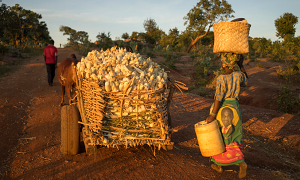
EL BATAN, Mexico — Large surface area and low population density make Zambia one of the most land abundant countries in the world.
However, despite this abundancy new data shows that land access is of mounting concern for smallholders. 54 percent of Zambia’s land is under customary tenure, far less than the 94 percent often utilized in land policy documents, according to a new study. Customary land tenure refers to the systems that most rural African communities operate to express and order ownership, possession, and access, and to regulate use and transfer. Unlike introduced landholding regimes, the norms of customary tenure derive from and are sustained by the community itself rather than the state or state law.
Of this available land, most populations are clustered in just 5 percent that has reasonably good market access conditions. These areas are often located in regions with high levels of rainfall variability due to historical infrastructure investments. In addition, these regions are witnessing a rapid increase in land commodification, land alienation and declining fallow rates.
The study concludes that land policy alone is not sufficient to cope with the mounting land constraints experienced by the majority of rural people in Zambia. Investments in infrastructure and services to improve market access conditions and climate change adaption capacity in Zambia’s remaining customary land is a necessity. Land and economic development policies must be attentive to changing dynamics in customary land areas in order to ensure the future viability of the smallholder farming sector.
Read more about the study “The geography of Zambia’s customary land: Assessing the prospects for smallholder development” and other new publications from CIMMYT staff below:
- Effects of relay cover crop planting date on their biomass and maize productivity in a sub-humid region of Zimbabwe under conservation agriculture. 2016. Mhlanga, B.; Cheesman, S.; Maasdorp, B.; Mupangwa, W.; Munyoro, C.; Sithole, C.; Thierfelder, C. NJAS Wageningen Journal of Life Sciences. Online First.
- Postulation of rust resistance genes in Nordic spring wheat genotypes and identification of widely effective sources of resistance against the Australian rust flora. 2016. Randhawa, M.S.; Bansal, U.; Lillemo, M.; Miah, H.; Bariana, H.S.; Erenstein, O. Journal of Applied Genetics. Online First.
- Quantitative trait loci mapping reveals pleiotropic effect for grain iron and zinc concentrations in wheat. 2016. Crespo-Herrera, L.A.; Singh, R.P.; Velu, G. Annals of Applied Biology. 169 (1) : 27-35.
- The geography of Zambia’s customary land : assessing the prospects for smallholder development. 2016. Sitko, N.J.; Chamberlin, J. Land Use Policy 55 : 49-60.
- Wheat landraces production on farm level in Turkey; Who is growing in where?. 2016. Kan, M.; Ortiz-Ferrara, G.; Kucukcongar, M.; Keser, M.; Ozdemir, F.; Muminjanov, H.; Qualset, C.; Morgounov, A.I. Pakistan Journal of Agricultural Sciences 53(1) : 159-169.
 Innovations
Innovations 
